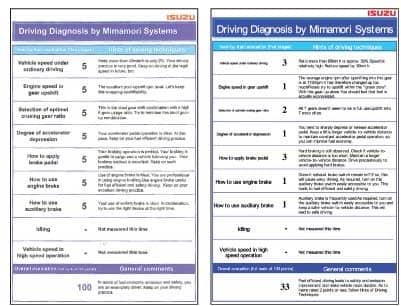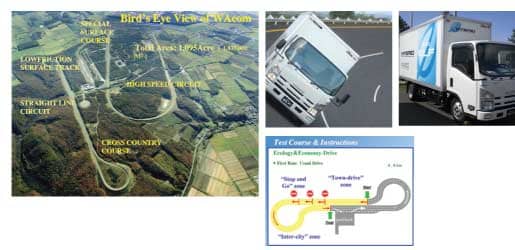A little bit of driver education can improve even experienced drivers’ fuel efficiency by 25 to 30%.
Operations by Dan Bolger
Until put to the test recently, I thought I was still a very good truck driver. That was until I represented FURNITURE WORLD Magazine at the Isuzu Fuel Economy Challenge with 15 other logistics and transportation editors. The most important thing learned was that training existing drivers offers immediate short term opportunities to reduce fuel usage 25% or more. My fuel economy improved 30% while only reducing average speed by 3 miles per hour.
In addition to concerns over 2008 fuel costs, all truck manufacturers and truck operators are faced with the next mandate to reduce truck engine emissions in 2010. The United States will have the world’s most stringent requirements when those kick in. Without being overly technical, this article will provide short term and longer term strategies as well as green initiatives.
The “The New Delivery Trucks”, article in the October 2004 issue of Furniture World (posted to the Operations Management article archive on the furninfo.com website) noted increased interest in Low Cab Forward (LCF) delivery trucks for fuel economy, maneuverability, reliability and ease of loading/unloading. Isuzu is a leading supplier of LCF trucks to the USA offering box sizes up to 24 feet and 19,800 GVW for 2009.
FURNITURE WORLD’s January 2008 “Beautiful Truck Contest” pictured Isuzu LCF entries from Michael Alan, Interior Ideas, Circle Furniture, Verlo Mattress Factory Stores and Ivan Smith Furniture.
The question on your mind at this moment is most likely “How can we achieve immediate substantial fuel savings with our current equipment?” FURNITURE WORLD Magazine briefly touched on professional driving techniques in the July 2008 issue, but on this trip the importance of driver training was reinforced by actual driving experience. The Fuel Economy Challenge was held at Isuzu’s Wacom Hokkaido proving ground, a 1,200 acre facility with every conceivable road and off road condition. In essence, fuel economy is affected by the vehicle, traffic conditions and the driver. We drove three fully loaded identical 13,800# GVW trucks on a test track. Only driver actions could affect fuel economy.

Above are results from two test runs. The run with the score of 33 includes some of the following coaching.
- Ratio more than 40mph is approximately 39. Speed is
relatively high. Reduce speed by 6mph.
- Average engine rpm after upshifting into this gear is at 1780 rpm. Try to upshift within the "green zone". Upshift into 7 more often.
- You tend to sharply depress or release accelerator pedal. Keep a little longer vehicle-to-vehicle distance to maintain constant accelerator pedal operation.
- Hard braking is still observed. Check if vehicle-to-vehicle distance is too short. Maintain a longer vehicle-to-vehicle distance.
- If exhaust brake switch remains on this will cause wavy driving. As required, turn on the auxiliary brake switch easily accessible to you.
- Auxiliary brake is frequently used. As required, turn on the auxiliary brake switch and keep a safer vehicle-to-vehicle distance.
Each vehicle was equipped with Mimamori electronic monitoring that relayed extensive data from the vehicle. The test course simulated city stop and go driving, highway driving and Interstate conditions. After a familiarization run for every driver, we returned to a classroom to review results, watched a 22 minute video and discussed fuel economy driving concepts using a workbook. Then we went back on the course for another run keeping in mind the following concepts:
• Vehicle speed under ordinary driving.
• Engine speed in gear upshift.
• Selection of cruising gear ratio.
• Degree of accelerator depression.
• How to apply brake pedal.
• How to use engine brake.
• How to use auxiliary brake.
• Idling.
• Vehicle in high speed operation.
The scorecard summarizing four pages of backup for my second run is shown in the exhibit showing an overall improvement in score from 81 to 100. CO2 was reduced 24% and NOx decreased 33%. That’s a lot of trees.

Test track photos and a diagram of the test track showing “town”, “stop and go” and “inter city” drive zones. Also pictured is a new hybrid from Isuzu.
Check the exhibit for tips that would accompany a less skillful run. Despite the fact that I have coached drivers on fuel economy, the review helped increase my fuel economy results 30% from 14.9 to 19.4 miles per gallon. Percentage improvements of our group were consistent with results from 12,000 previous participants.
The bottom line from the Fuel Economy Challenge is that regardless of the brand of trucks you use for delivery, you have the opportunity to save thousands of dollars annually through driver training and motivation. If your deliveries are by independent contractors, their bottom line can also benefit. Proper maintenance and tire pressures are also significant additional contributors.
2010 Emissions rules
Subsequent to the Fuel Economy Challenge, we were updated on approaches being taken to meet 2010 emissions requirements. Technology for 2010 requirements is considerably more sophisticated than the hurdles for 2007. We also drove vehicles with other drive train technologies. There may be a Compressed Natural Gas truck or a Hybrid truck in your fleet soon, but improved diesels will be the heavy hauling mainstay for many years.
Isuzu plans a 2009 Fuel Economy Challenge in the USA that will be of real interest to their users. While I’m not aware of other manufacturers’ specific plans, today’s competitive environment demands thinking along similar lines to help their users be successful. My bottom line recommendation is to talk to your resources to check out approaches that will make you more efficient and to move toward green for short and long term gains.
Daniel Bolger P.E. provides operations consulting services to clients throughout North America. FURNITURE WORLD Magazine readers can contact Dan directly at bolger@furninfo.com.